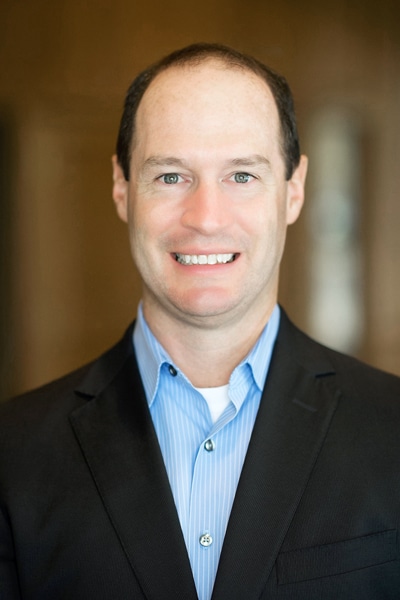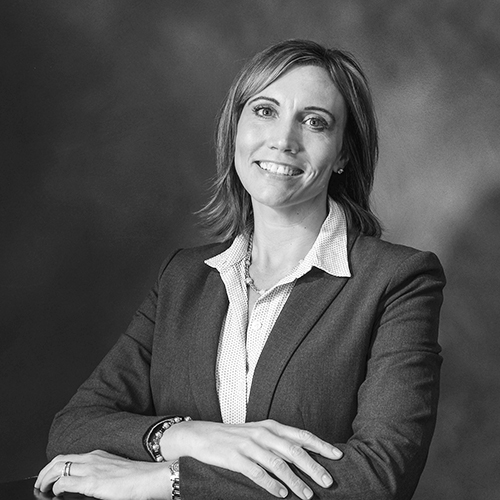Many young pharmacists begin their careers in retail pharmacy, but Michael Einodshofer was not just there for a paycheck. He realized quickly just how important pharmacists and the medications they dispense are in the patient’s health journey. “It’s the last mile of healthcare—where diagnosis ends and treatment begins,” he says. “Everything I do now comes back to that experience at the pharmacy counter.”
However, Einodshofer’s days of filling prescriptions and counseling patients are long behind him. Instead, he’s taken steps in his career to see where he can make a greater impact in the industry. “Having the best drugs in the world doesn’t matter if patients can’t afford them. This industry needs to find ways to drive waste out of healthcare and enable patients to make better decisions financially and clinically,” he says.

Einodshofer graduated from the University of Pittsburgh with his bachelor’s of science in pharmacy in 1997, and he began his work as a retail pharmacist immediately after. An MBA followed not long after, and Einodshofer transitioned from retail to the hospital and health plan side of pharmacy. After nearly ten years in leadership roles such as director of pharmacy operations at the UPMC Health Plan, he joined the Walgreens Boots Alliance specializing in projects focused on specialty cost containment, new drug forecasting, and clinical care. He also brought a new focus on data-driven solutions for clients, advanced analytics, and established other forward-thinking strategies.
After advancing into senior director roles, pharmacy benefit management company Maxor National Pharmacy Services offered him an opportunity to find new avenues for improving the health of millions. Einodshofer became the company’s chief innovation officer in 2016, a position that allows him to look across business teams and think creatively. His direct team is responsible for helping each business unit within Maxor adopt new technologies and approaches to their business via analytics and new clinical intervention programs that improve overall healthcare quality and client experience.
The healthcare world appealed to Einodshofer because it is, in a sense, a massive sandbox—at once anything is possible, but so much still needs to be determined. “It’s so complex and interconnected that it’s hard to change things quickly, but we’re making great progress,” he says. Across the industry, web-based self-service tools have become standard in the last decade, empowering patients and members with access to information, but there remains health literacy barriers that limit adoption of these tools.
One way that Einodshofer and Maxor have worked to change that has been a shift from expecting a patient to know what questions to ask to developing solutions that find a patient who didn’t know they had a question. “Instead of expecting the consumer to find the content, we have the content and find the consumer,” he says. The company recently launched myMaxorLink, for example. This product allows the data analytics team to find patients that might benefit from a lower-cost alternative drug, gap in care, or another issue. They then deliver information through a HIPAA-compliant myMaxorLink mobile messaging platform so it can be actionable in a timely, clear manner. “Alerting a patient to a lower-cost alternative can save thousands of dollars a year, yet likely would have gone unnoticed if we expected the patient to find such opportunity on their own,” he says.
“Alerting a patient to a lower cost alternative can save thousands of dollars a year, yet likely would have gone unnoticed if we expected the patient to find such opportunity on their own.”
“Relay Network is proud to provide the technology behind myMaxorLink, a first-of-its-kind mobile engagement solution in the PBM industry that connects patients to individualized solutions right in their moments of need,” says Matt Gillin, CEO of Relay Network.
But across all projects, one of Einodshofer’s biggest priorities is to remove waste, both for the benefit of Maxor and downstream for patients and plan sponsors. “Maxor gives me a lot of hands-on opportunities to interact with patients to deliver cost-effective care,” he says. “My analytics team is sharing things the clinician might not have noticed in their standard interactions with a patient. But we can see patterns in data beyond what a patient is telling them at the point of sale.”
Within Maxor’s Specialty Pharmacy business unit, Maxor has done a lot of important work in cystic fibrosis (CF), priding itself at excelling in the disease space. “We work closely with all manufacturers in the CF space and are one of a just a few pharmacies in the country that can provide every CF medication to patients. We also selectively look from other manufacturer partners outside of CF that might have an interest in working with a specialty pharmacy dedicated to patient and provider services,” Einodshofer says.
But to get all of the various teams to work together toward those goals, Einodshofer needs to build a culture of success. “I’ve seen a variety of leadership styles in my career, and it’s most effective when a leader wants their people to succeed and enables it,” he says. If you hire the right people in the first place, Einodshofer suggests, then trusting them to take ownership, act responsibly, and work productively should come naturally. “I’ve learned how important it is to respect the champion’s creed—always do the most productive thing in any given moment,” he says.
The value of every minute couldn’t be clearer than when discussing the company’s ability to help patients live longer, healthier lives. And, too often, patients aren’t able to do so because they either can’t afford the necessary drugs, or they don’t understand how different delivery channels can improve affordability.
“We are setting out to change the narrative around the affordability of drugs,” Einodshofer says. “There is a significant amount of waste on drugs that don’t deliver healthcare value, yet are actively promoted for the manufacturers’ economic gain. Our mission is pull the curtain back for our plan sponsors, call out where money is being wasted, change benefit design accordingly, and launch intervention programs that maintain affordability and maximize quality outcomes within the pharmacy benefit.”

